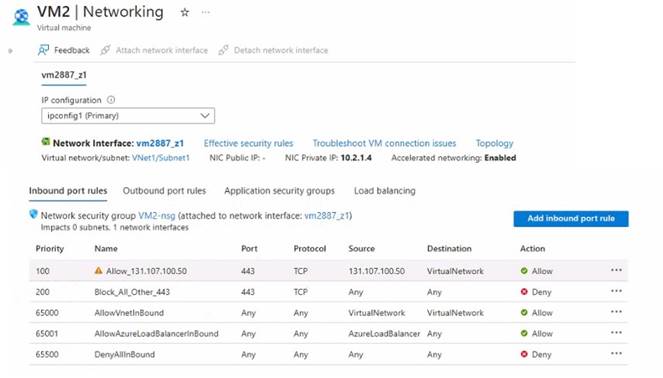- (Topic 5)
You have an Azure subscription that contains a storage account named storage1.
You plan to use conditions when assigning role-based access control (RABC) roles to storage1
Which storage1 services support conditions when assigning roles?
Correct Answer:
A
"Currently, conditions can be added to built-in or custom role assignments that have blob storage or queue storage data actions. " https://learn.microsoft.com/en-us/azure/role- based-access-control/conditions-overview#where-can-conditions-be-added
- (Topic 5)
You have an Azure AD tenant that is linked to 10 Azure subscriptions. You need to centrally monitor user activity across all the subscriptions. What should you use?
Correct Answer:
B
https://learn.microsoft.com/en-us/azure/azure-monitor/essentials/activity-log?tabs=powershell#send-to-log-analytics-workspace Send the activity log to a Log Analytics workspace to enable the Azure Monitor Logs feature, where you: - Consolidate log entries from multiple Azure subscriptions and tenants into one location for analysis together.
- (Topic 5)
After you answer a question in this section, you will NOT be able to return to it. As a result, these questions will not appear in the review screen.
You have an app named App1 that is installed on two Azure virtual machines named VM1 and VM2. Connections to Appl are managed by using an Azure Load Balancer.
The effective network security configurations for VM2 are shown in the following exhibit.
You discover that connections 10 Appl from 131.107.100.50 over TCP port 443 fail. You verity that the Load Balancer rules are configured correctly.
You need to ensure that connections to Appl can be established successfully from 131.107.100.50 over TCP port 443.
Solution: You create an inbound security rule that allows any traffic from the Azureload Balancer source and has a priority of 150.
Does this meet the goal?
Solution:
Does this meet the goal?
Correct Answer:
A
- (Topic 5)
You have an Azure subscription that contains a storage account. The account stores website data.
You need to ensure that inbound user traffic uses the Microsoft point-of-presence (POP) closest to the user's location.
What should you configure?
Correct Answer:
D
Routing preference is a feature that allows you to configure how network traffic is routed to your storage account from clients over the internet. By default, traffic from the internet is routed to the public endpoint of your storage account over the Microsoft global network, which is optimized for low-latency path selection and high reliability. Both inbound and outbound traffic are routed through the point of presence (POP) that is closest to the client. This ensures that traffic to and from your storage account traverses over the Microsoft global network for the bulk of its path, maximizing network performance. You can also change the routing preference to use internet routing, which minimizes the traversal of your traffic over the Microsoft global network, handing it off to the transit ISP at the earliest opportunity. This lowers networking costs, but may compromise network performance. Therefore, to ensure that inbound user traffic uses the Microsoft POP closest to the user’s location, you should configure routing preference to use the Microsoft global network as the default routing option for your storage account.
References:
✑ Network routing preference for Azure Storage ✑ Configure network routing preference for Azure Storage
✑ Configure network routing preference for Azure Storage
- (Topic 5)
Note: This question is part of a series of questions that present the same scenario. Each question in the series contains a unique solution that might meet the stated goals. Some question sets might have more than one correct solution, while others might not have a correct solution.
After you answer a question in this section, you will NOT be able to return to it. As a result, these questions will not appear in the review screen.
You have an Azure virtual machine named VM1. VM1 was deployed by using a custom Azure Resource Manager template named ARM1.json.
You receive a notification that VM1 will be affected by maintenance. You need to move VM1 to a different host immediately.
Solution: From the Redeploy blade, you click Redeploy. Does this meet the goal?
Correct Answer:
A
Redeploying the virtual machine moves it to a new host within the same region and availability set. This can help resolve any underlying issues with the current host. Redeploying the virtual machine does not affect the configuration or data on the virtual machine. Then, References: [Redeploy Windows VM to new Azure node]